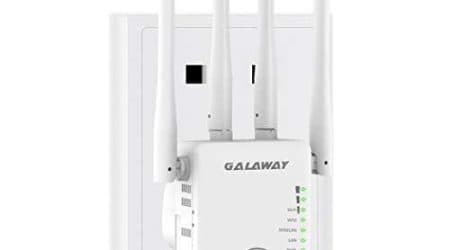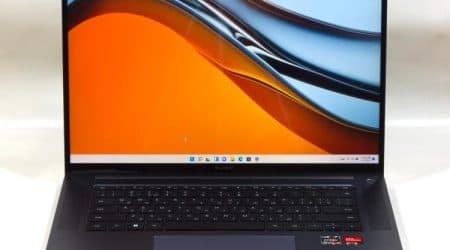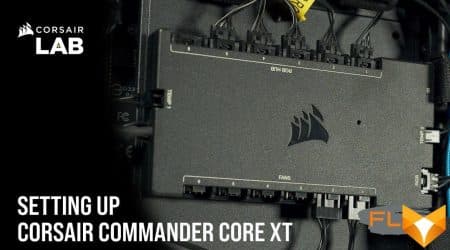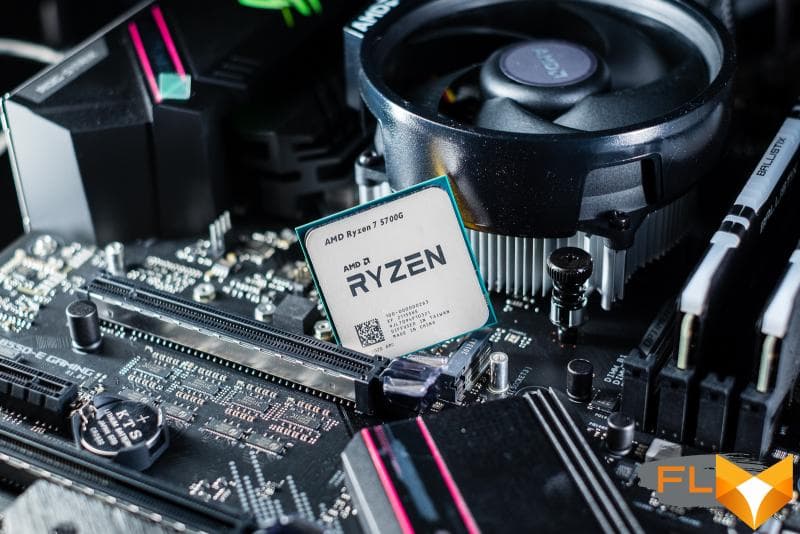


In early August, AMD expanded its range of Ryzen 5000 desktop processors to end users by 1.5x. The long established Ryzen 9 5950X and 5900X, Ryzen 7 5800X and Ryzen 5 5600X have been joined by two processors with integrated graphics. This pair is an octa-core Ryzen 7 5700G and a six-core Ryzen 5 5600G from the Cezanne series. Representatives of this series have been found in laptops and ready-made desktop systems offered by computer manufacturers for several months, but AMD decided to expand their habitat and sent them to retail.
And this is a really significant event that deserves a separate article. In conditions of a total shortage of video cards, hybrid processors with high-performance integrated graphics (APUs) are in high demand. They give gamers a chance to get through the “hard times” by waiting for the prices of powerful video cards to drop, and therefore the demand for them has grown a lot lately. However, until now, AMD has offered rather controversial hybrid solutions, to which there were various claims. For example, the Ryzen 5 3400G is just a quad-core APU, which is also built on the old Zen + microarchitecture and is manufactured using a 12nm process technology. The Ryzen 5 Pro 4650G and Ryzen 7 Pro 4750G that replaced it are more interesting in this regard – they received more cores and moved to a 7-nm process technology and a more recent Zen 2 microarchitecture. But not everything is so simple with them: formally, they are not designed for retail sales, and therefore their presence on store shelves is episodic.
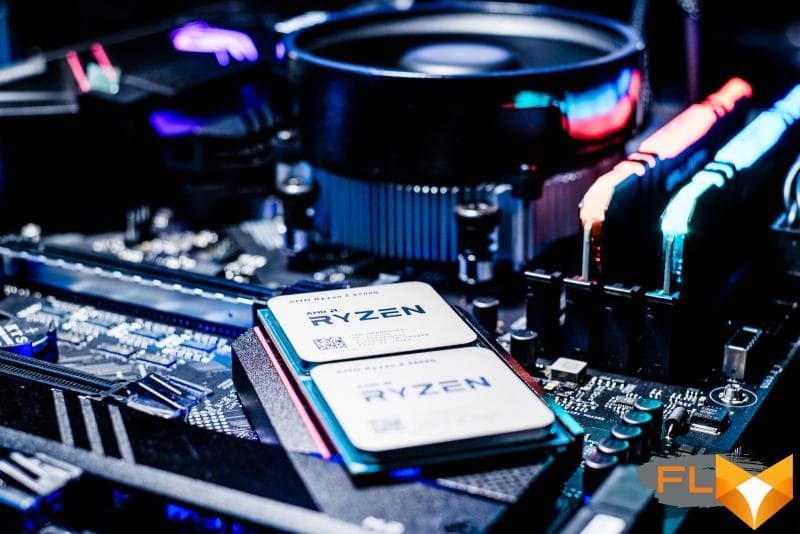
The new Ryzen 7 5700G and Ryzen 5 5600G at this disposition seem like real manna from heaven: thanks to them, the gamer can get at their disposal an entry-level gaming system, which can then be easily transformed into something more. For example, when the situation in the video card market settles down, a computer based on the Ryzen 7 5700G and Ryzen 5 5600G can be enhanced with a discrete video accelerator. Moreover, these APUs look like they have everything you need to pull not only mid-range, but even high-end video cards, because their processor part is similar to the full-fledged Ryzen 7 5800X and Ryzen 5 5600X (with some assumptions). But there is even more good news: the new Ryzen 7 5700G and Ryzen 5 5600G are not solutions for OEMs, like their predecessors were, but regular retail offers, the official cost of which is lower than that of the representatives of the Vermeer series (the usual desktop Ryzen 5000) with the same number of Zen 3 cores.
This means that representatives of the Cezanne family can be interesting even apart from their graphic capabilities. This is what AMD itself hints at. Among other things, the company calls the new products a downward expansion of the Ryzen 5000 desktop lineup, that is, it suggests seeing the younger eight-core in the Ryzen 7 5700G, and the younger six-core Zen 3 generation in the Ryzen 5 5600G. In other words, the expectations associated with Cezanne are huge and varied. And in this study, we will check the true capabilities of these hybrid processors and draw a conclusion to whom these processors can really come in handy.
⇡#Desktop Cezannes in detail
From an architectural point of view, the Ryzen 7 5700G and Ryzen 5 5600G desktop processors are exactly the same members of the Cezanne family as the processors that AMD has been supplying for laptops in the Ryzen 5000U and 5000H series since January of this year. They are based on the same 7nm semiconductor chip with an area of about 180 mm2, which packs 10.7 billion transistors.
At the same time, Cezanne processors, unlike their counterparts in the Vermeer desktop series, do not use chiplet topology. Their design uses a monolithic crystal, which combines eight Zen 3 cores combined into one CCX complex, and a Vega graphics core with eight CUs (computing units). Thus, compared to the previous version of the APU, codenamed Renoir, in Cezanne, the manufacturer replaced the cores with the Zen 2 architecture with more modern Zen 3.
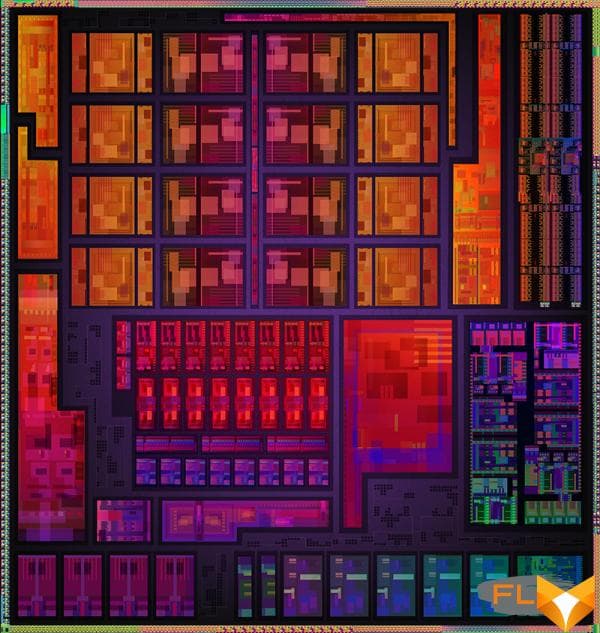
When looking at a photo of a Cezanne semiconductor crystal, it immediately catches the eye that the balance of resources in it is shifted towards the processor part. The Picasso chips (Ryzen 5 3400G) contained four Zen + cores, but the graphics had 11 compute units. In Cezanne, the number of computing cores doubled, and the graphics lost three computing units. But this does not mean that the old hybrid processors had a more powerful graphics part. AMD says that the reduction in the number of CUs has been successfully offset by higher clock speeds and optimizations in power management mechanisms.
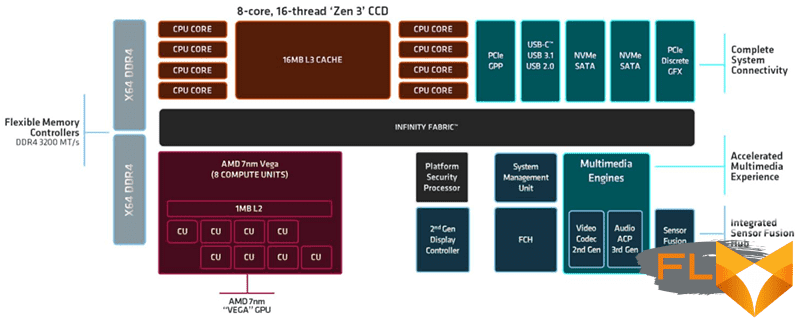
Another non-obvious point is the positioning of desktop Cezanne. There is no doubt that any processor with integrated graphics is in demand, especially now, but AMD says that its new APUs are extremely flexible processors that will be suitable for office computers and gaming builds at the same time. At the same time, the cost of representatives of the Ryzen 5000G series is quite high so that they become truly mass solutions. So far, AMD has only released the six-core and eight-core models to the public, and they are shipped in the “above $250” price range. Thus, the company is still not ready to transfer solutions based on Zen 3 into the category of mass solutions. Rather, AMD’s calculation is to make the Ryzen 7 5700G be perceived as the youngest eight-core new generation, like the unreleased Ryzen 7 5700X, and the Ryzen 5 5600G in this logic should serve as an alternative to the hypothetical Ryzen 5 5600.
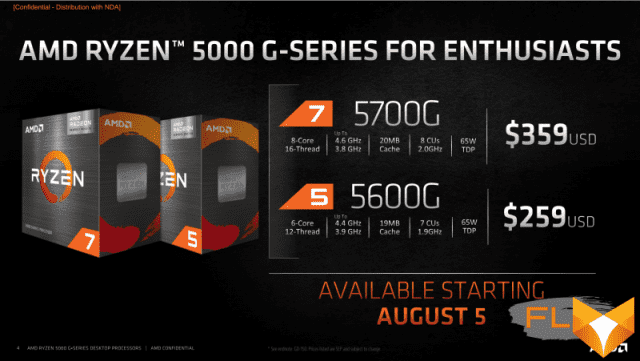
Accordingly, the technical specifications of the Ryzen 7 5700G and Ryzen 5 5600G are also formed. The processors are very close in frequency formula to the Ryzen 7 5800X and Ryzen 5 5600X, have the same microarchitecture of the CPU part, and the difference in performance is determined mainly by the fact that the Cezanne processors have cut down the L3 cache – its capacity is not 32, but 16 MB.
The following table contains the characteristics of all currently available processors for Socket AM4, related to the 5000 series and based on the Zen 3 microarchitecture. It allows you to understand how AMD has built hybrid innovations into the existing lineup.
| Codename | Cores/Threads | Basic/max. frequency, GHz | L3 cache, MB | GPU | TDP, W | Price | |
|---|---|---|---|---|---|---|---|
| Ryzen 9 5950X | Vermeer | 16/32 | 3.4/4.9 | 64 | – | 105 | $799 |
| Ryzen 9 5900X | Vermeer | 12/24 | 3.7/4.8 | 64 | – | 105 | $549 |
| Ryzen 7 5800X | Vermeer | 8/16 | 3.8/4.7 | 32 | – | 105 | $449 |
| Ryzen 7 5700G | Cezanne | 8/16 | 3.8/4.6 | 16 | Vega 8 | 65 | $359 |
| Ryzen 5 5600X | Vermeer | 6/12 | 3.7/4.6 | 32 | – | 65 | $299 |
| Ryzen 5 5600G | Cezanne | 6/12 | 3.9/4.4 | 16 | Vega 7 | 65 | $259 |
Both Cezanne processors, in addition to the integrated GPU and halved L3 cache, are also distinguished by a strict thermal package of 65 W, which should be taken as a reference to their mobile origin. Of particular interest here is the eight-core Ryzen 7 5700G, since so far AMD has not offered economical eight-cores on the Zen 3 architecture, and Cezanne may well turn out to be such, not for nothing that a newer version of the 7-nm process technology with reduced leakage currents is used for their production. .
And by this point, it begins to seem that AMD has released such attractive processors that they even outshine their counterparts without integrated graphics. However, there is no need to rush.
First, we don’t yet know how halving the L3 cache will affect real performance. Moreover, the latency of the cache memory subsystem of Cezanne does not differ from that of Vermeer, that is, a decrease in the amount of cache memory in new processors did not give any gain in L3 cache latency – it remained at the level of 46 cycles as it was.
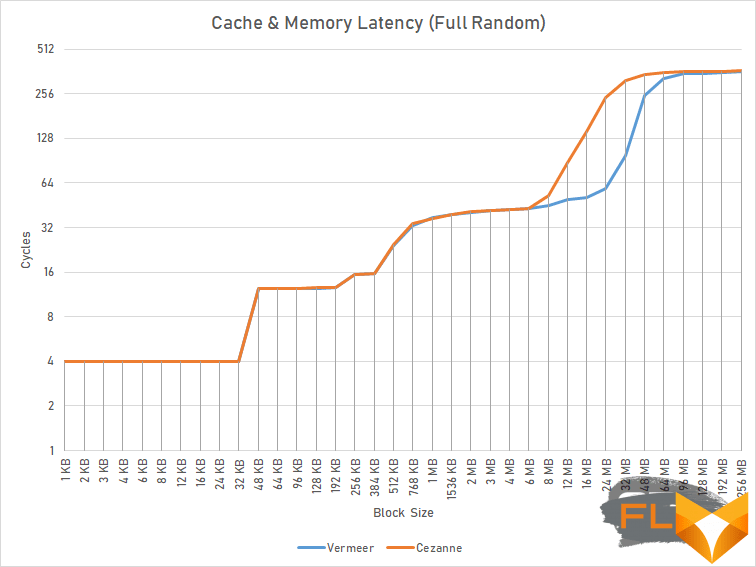
Secondly, real prices spoil the impression of Cezanne: at the moment, Ryzen 7 5700G and Ryzen 5 5600G are not cheaper at all than Ryzen 7 5800X and Ryzen 5 5600X. Therefore, while talking about Cezanne as an alternative to Vermeer, there is no point.
In addition, there is a “third”. The Ryzen 7 5700G and Ryzen 5 5600G have another non-obvious flaw: they cut down on the integrated PCI Express controller. Both APUs have 24 PCIe lanes, but that’s only PCIe3.0. 16 lines are assigned to work with discrete graphics, 4 lines go for drives, and the remaining 4 lines are required for connecting to the chipset. Thus, an external video card, when installed in a system based on a desktop Cezanne, will operate at maximum in PCIe 3.0 mode. It will not be possible to use the latest PCIe 4.0 SSDs at full speed with these processors.
But at the same time, the Ryzen 7 5700G and Ryzen 5 5600G should not have any compatibility issues. They can be easily used in all variety of motherboards with Socket AM4 processor socket. The criterion for their support is BIOS based on AGESA 1.2.0.3B and newer libraries, and AGESA 1.1.8.0 is enough for the board to at least start up for a subsequent firmware update.
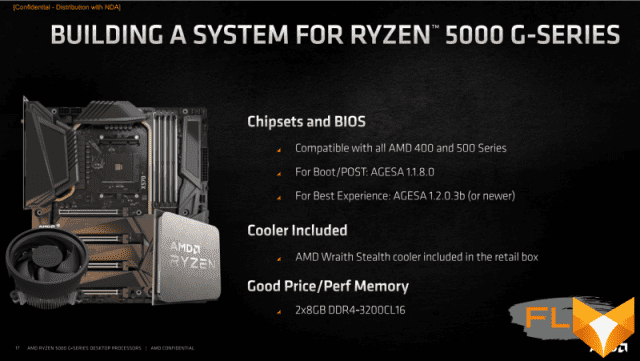
AMD originally recommended motherboards based on the B550 chipset for use with Cezanne, citing the fact that X570 motherboards often lack video outputs. But by and large, neither system logic makes much sense, since hybrid processors do not support PCIe 4.0. Therefore, platforms with the B450 chipset are quite suitable for the Ryzen 7 5700G and Ryzen 5 5600G. But for them, unfortunately, there are not always compatible BIOS versions – this point needs to be checked separately.
⇡#Ryzen 7 5700G and Ryzen 5 5600G Closeup
The older of the two models in the Cezanne desktop pair, the Ryzen 7 5700G, is an octa-core, 16-thread processor with a maximum frequency of 4.6 GHz. The TDP of this APU is set to 65W, but on most motherboards its actual consumption is limited to a higher value of 88W. However, this is still noticeably less than the 142 W that the slightly faster Ryzen 7 5800X without integrated graphics is allowed to take from the motherboard.
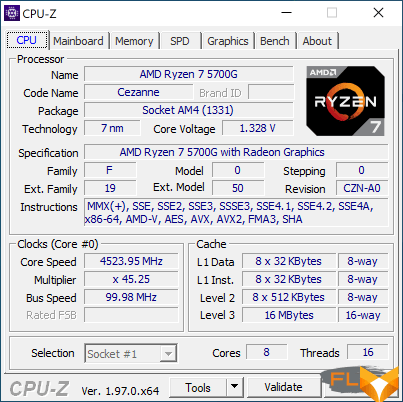
It seems that such a strict limitation of power consumption should lead to a noticeable decrease in real frequencies, but in reality this is not the case. With a load on all cores in the same Cinebench R23, the Ryzen 7 5700G processor stably keeps the frequency at 4.3-4.4 GHz – this is only 200 MHz lower than the Ryzen 7 5800X frequency in the same mode. The full picture of the dependence of the real frequency on the load is presented in the graph below – it is built in the rendering test using a different number of threads.
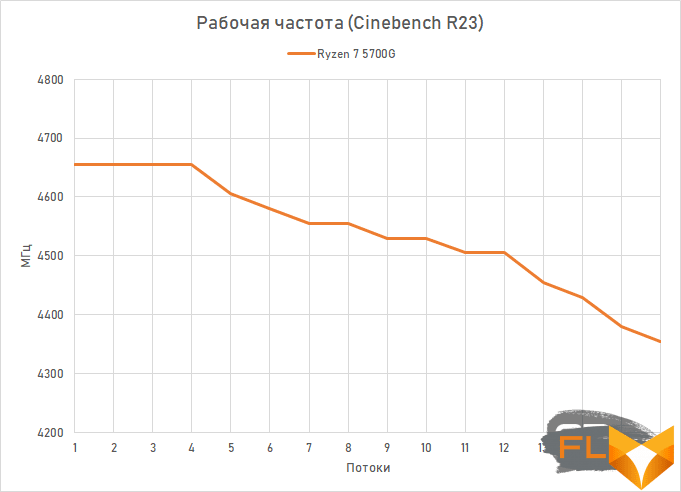
In a separate line, it should be noted that the Ryzen 7 5700G, which has mobile roots, does not demonstrate the same terrible temperatures that the Ryzen 7 5800X is famous for. If for an octa-core without graphics, even when using a custom liquid cooling system in Cinebench R23, temperatures of 85-90 degrees could be seen, then the maximum temperature of the Ryzen 7 5700G under the same conditions is about 70 degrees. This is natural: as stated in the specifications, the eight-core Cezanne processor has a lower real heat dissipation, which at high load differs from the consumption of the Ryzen 7 5800X by more than one and a half times.
The graphs below compare the instantaneous consumption and temperature of the Ryzen 7 5700G and Ryzen 7 5800X when rendering in Cinebench R23 when using liquid CPU cooling on EKWB components.
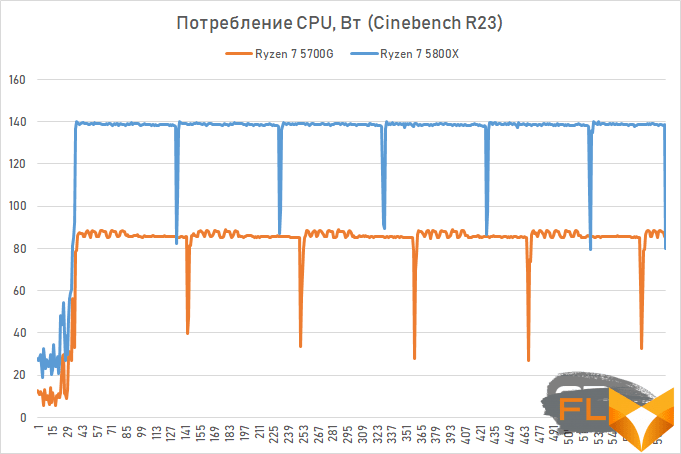
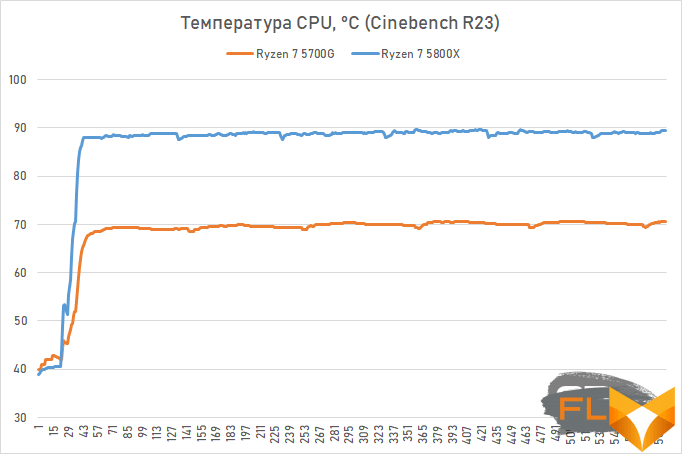
And here is a similar pair of graphs built for the same processors under game load in Horizon Zero Dawn. In both cases, the system uses discrete graphics.
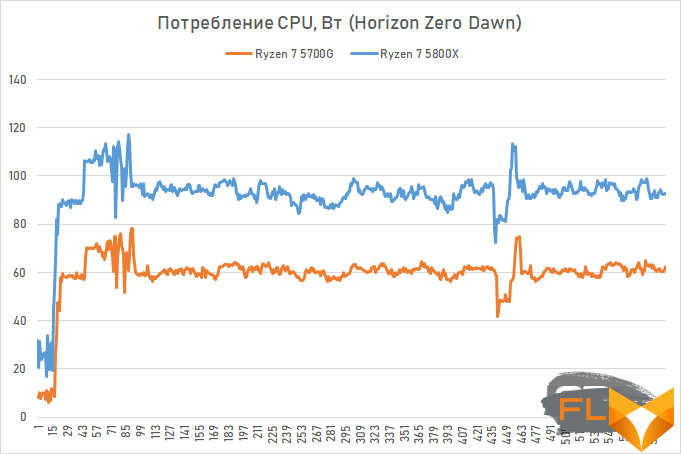
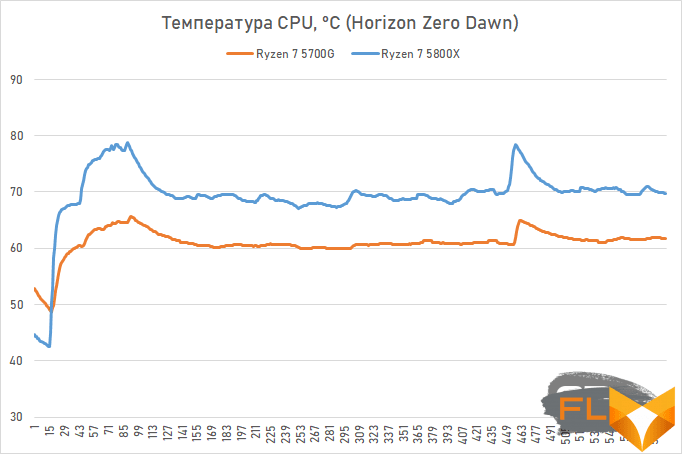
It is rather symptomatic that the significant difference between the Ryzen 7 5700G and Ryzen 7 5800X in temperature and consumption continues in Horizon Zero Dawn. In the gaming load, the Ryzen 7 5700G is more economical than the Vermeer family processor by about 15-20 W, and its temperature is 5-10 degrees lower.
The second processor in the family of updated retail offerings with integrated graphics, the Ryzen 5 5600G, has six cores and 12 threads in its arsenal. The maximum frequency of this processor is 4.4 GHz, the thermal package is 65 watts.
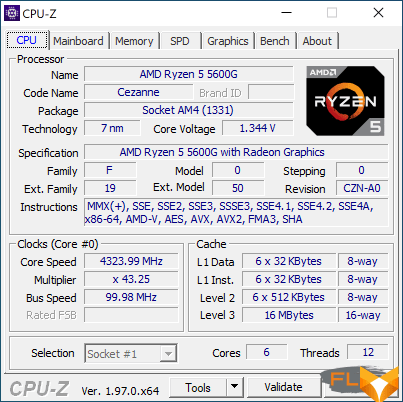
One would think that with such characteristics, this CPU should withstand a frequency of about 4.4 GHz even under full load, but no – it drops to 4.3 GHz. Confirmation of this is the graph below of the dependence of the frequency on the number of active rendering threads in Cinebench R23.
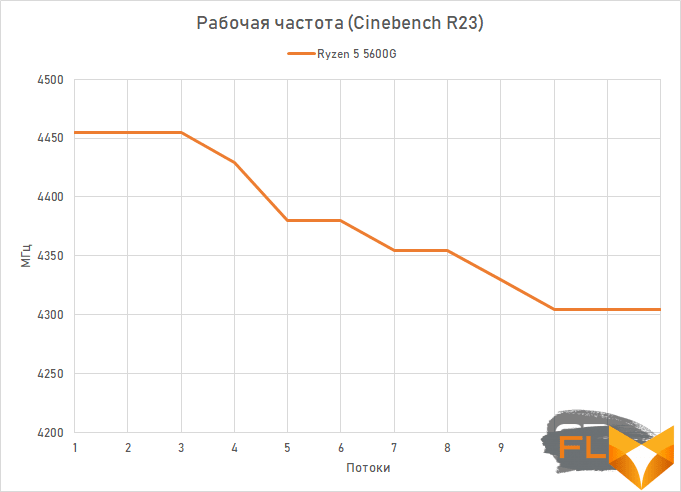
Thus, despite the same restrictions on heat dissipation and power consumption, the Ryzen 5 5600G is inferior to the Ryzen 5 5600X in real frequencies by about 150-300 MHz, that is, even more than the 65-watt Ryzen 7 5700G is inferior to the 105-watt Ryzen 7 5800X.
Strangely enough, the gap in the frequencies of the Cezanne and Vermeer six-core processors is almost not reflected in real consumption and temperature. If you look at the picture that is obtained in Cinebench R23, it turns out that the Ryzen 5 5600G and Ryzen 5 5600X consume about the same, but the operating temperature of the representative of the Cezanne family is several degrees higher.
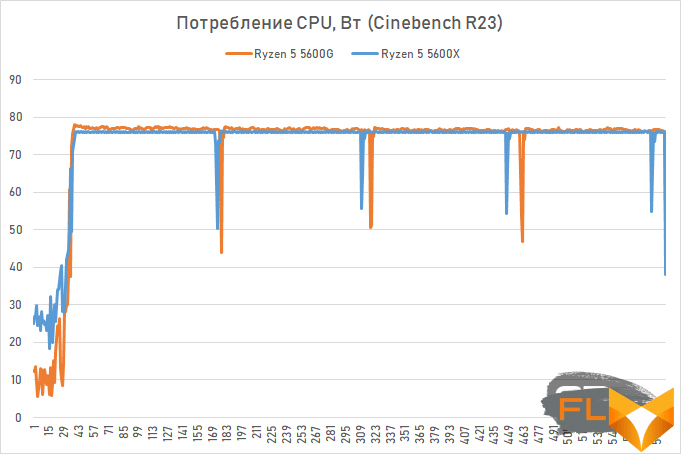
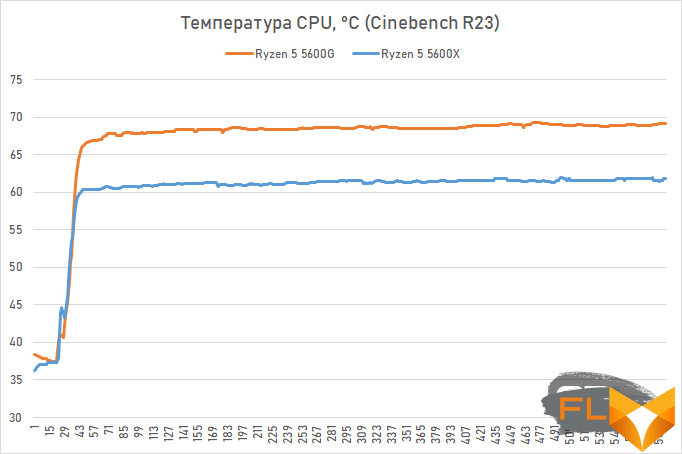
It is rather difficult to offer a reasonable explanation for such a picture. The internal thermal interface in the Ryzen 5 5600G is the same as in the Ryzen 5 5600X, that is, the processor cover is soldered to the silicon chip. At the same time, the area of \u200b\u200bthe crystal of the Ryzen 5 5600G is more than two times larger, and it should be easier to remove heat from it. Therefore, it remains only to refer to the fact that the computational cores in Cezanne are grouped closer together in a semiconductor crystal due to the reduced L3 cache.
Even more interesting is the situation in the game. Here, the Ryzen 5 5600X already demonstrates noticeably higher consumption, since the Precision Boost technology is configured more aggressively in it. This is also reflected in the temperature regime: the processor of the Vermeer family in the game load heats up a couple of degrees more.

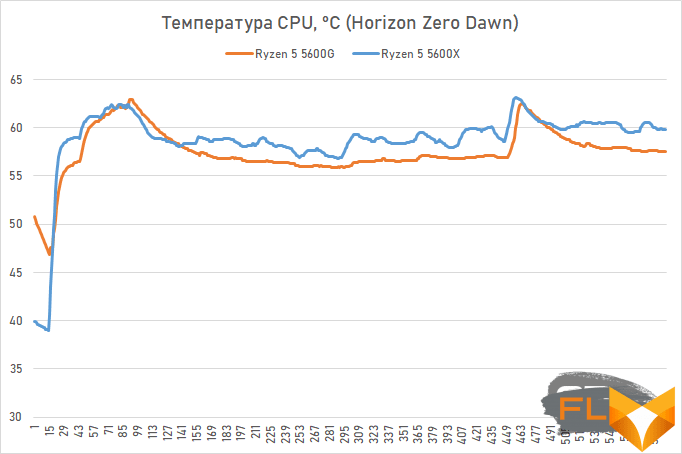
However, for the Ryzen 7 5700G and Ryzen 5 5600G hybrid processors, the manufacturer has set the same temperature limits as for the usual Vermeer. Their maximum temperature according to the specifications should not exceed 95 degrees. Moreover, in the boxed delivery, AMD applies a 300-gram Wraith Stealth aluminum cooler to them, which, according to the company, should be quite enough for heat dissipation. This, recall, is the simplest option among all Wraith, which comes with the Ryzen 5 5600X as well.
However, moderate heating and low heat dissipation of Cezanne desktop processors does not mean at all that they have a serious frequency potential. The test showed that these processors are rather reluctant to overclock – worse than the usual Ryzen without integrated graphics. The maximum frequency (with synchronous overclocking of all cores) at which the eight-core Ryzen 7 5700G was able to maintain stability turned out to be 4.6 GHz, and the frequency for the six-core Ryzen 5 5600G was 4.5 GHz.

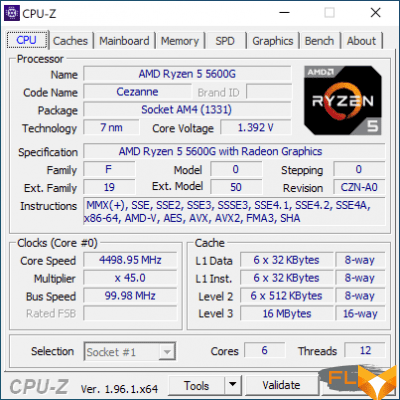
Such overclocking was achieved by increasing the processor supply voltage to 1.35-1.4 V. The temperature under load in this case approached the limit of 95 degrees. In other words, you should not count on the possibility of a serious increase in Cezanne’s performance, and it is better to immediately resort to either the Precision Boost Override function or nuclear overclocking for this purpose.
⇡#Vega Integrated Graphics
In the processors of the Cezanne family, the bulk of the changes occurred on the side of the computing cores. However, AMD itself claims that the graphics core built into the new APU has become better when compared with Picasso processors (3000G series). However, we are not talking about any significant steps here, at least this is the conclusion that can be drawn from the Cezanne specifications. For example, the graphics in the Ryzen 5000G processors belong to the Vega class, that is, it has the GCN architecture, which the company abandoned in discrete graphics cards back in 2019.
The lack of clear progress in this direction is a very disappointing fact. It seems that the modern graphics architecture of RDNA 2 could significantly push the power of integrated graphics up. After all, a capacious caching system Infinity Cache appeared in it, which increases the efficiency of the GPU with memory, which could bypass one of the main bottlenecks of graphics accelerators built into the processor. But there is nothing like this in Cezanne, so we can only hope that AMD was able to achieve acceptable performance for Vega graphics, which wanders in the company’s hybrid processors from generation to generation.
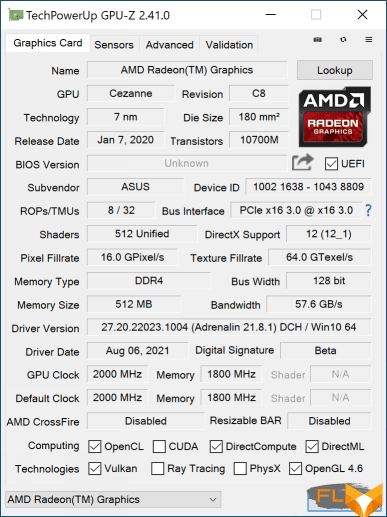
In the technical press materials that AMD distributed with the Ryzen 5000G processors, not a word is said about any specific graphics improvements compared to previous generation offerings. Therefore, it is logical to assume that the Vega core in the Cezanne family does not differ from the one used in the Renoir processors (4000G series). Moreover, the new Ryzen 5000G cannot even boast of the improvements made along the extensive path – they do not offer either more computing units or increased frequencies.
This means that the Ryzen 7 5700G graphics with 8 compute units (and thus 512 FP32 arithmetic units) are similar to the Ryzen 7 Pro 4750G graphics. At the same time, 11 computing units were incorporated in the Ryzen 5 3400G hybrid processor of the earlier Picasso family, but there they worked at a much lower frequency. The modern 7nm process technology used by both Cezanne and Renoir made it possible to bring the frequency of the integrated GPU to values of the order of 2.0 GHz, while in 12-nm Picasso processors the graphics worked no faster than 1.4 GHz.
| Cores/Threads | Basic/max. frequency, GHz | GPU | GPU compute units | GPU frequency, GHz | TDP, W | |
|---|---|---|---|---|---|---|
| Ryzen 7 5700G | 8/16 (Zen 3) | 3.8/4.6 | Vega (CGN) | 8 CU (512 ALU) | Before 2.0 | 65 |
| Ryzen 5 5600G | 6/12 (Zen 3) | 3.9/4.4 | Vega (CGN) | 7 CU (448 ALU) | Up to 1.9 | 65 |
| Ryzen 7 Pro 4750G | 8/16 (Zen 2) | 3.6/4.4 | Vega (CGN) | 8 CU (512 ALU) | Before 2.1 | 65 |
| Ryzen 5 Pro 4650G | 6/12 (Zen 2) | 3.7/4.2 | Vega (CGN) | 7 CU (448 ALU) | Up to 1.9 | 65 |
| Ryzen 5 3400G | 4/8 (Zen+) | 3.7/4.2 | Vega (CGN) | 11 CU (704 ALU) | Up to 1.4 | 65 |
| Ryzen 3 3200G | 4/4 (Zen+) | 3.6/4.0 | Vega (CGN) | 8 CU (512 ALU) | Up to 1.25 | 65 |
If we talk about the six-core Ryzen 5 5600G processor, then one of the computing units is disabled for the GPU, so its graphics core resources are limited to 448 FP32 arithmetic units. Along the way, the frequency of the GPU is also slightly reduced – it is 1.9 GHz versus 2.0 GHz for the older representative in the series.
Before we move on to gaming tests, it must be said that the frequencies indicated for the Vega integrated graphics are hard-coded values. Although we have long been accustomed to dynamically adjusting the GPU frequencies of discrete graphics cards, in Cezanne the GPU frequency does not depend on power consumption, temperature, or load. It drops only when idle or when the OS desktop is displayed, but with any 3D activity it is set to a constant 2.0 GHz for the Ryzen 7 5700G and 1.9 GHz for the Ryzen 5 5600G.

However, fixed frequencies are not an architecture limitation. There is no doubt that Vega graphics are technically trained to dynamically change the frequency – think, for example, the Radeon RX Vega 56/64. Most likely, the graphics core inside the Cezanne can simply run at its maximum target frequency without suffering from high power consumption or temperatures. So, the maximum consumption of the built-in GPU, seen in the tests, was only 35 watts.
⇡#Description of test systems
Today’s testing includes testing the Ryzen 7 5700G and Ryzen 5 5600G both when used with integrated graphics accelerators and with a discrete graphics card installed. Therefore, the set of equipment that was involved in the preparation of this material is much wider than is usually the case.
- Processors:
- AMD Ryzen 7 5800X (Vermeer, 8 cores + SMT, 3.8-4.7GHz, 32MB L3);
- AMD Ryzen 7 5700G (Cezanne, 8 cores + SMT, 3.8-4.6GHz, 16MB L3);
- AMD Ryzen 5 5600X (Vermeer, 6 cores + SMT, 3.7-4.6GHz, 32MB L3);
- AMD Ryzen 5 5600G (Cezanne, 6 cores + SMT, 3.9-4.4GHz, 16MB L3);
- AMD Ryzen 7 Pro 4750G (Renoir, 8 cores + SMT, 3.6-4.4GHz, 8MB L3);
- AMD Ryzen 5 Pro 4650G (Renoir, 6 cores + SMT, 3.7-4.2GHz, 8MB L3);
- AMD Ryzen 7 3800XT (Matisse, 8 cores + SMT, 3.8-4.7GHz, 32MB L3);
- AMD Ryzen 5 3600 (Matisse, 6 cores + SMT, 3.6-4.2GHz, 32MB L3);
- AMD Ryzen 5 3400G (Picasso, 4 cores + SMT, 3.7-4.2GHz, 4MB L3);
- Intel Core i7-11700K (Rocket Lake, 8 cores + HT, 3.6-5.0 GHz, 16MB L3);
- Intel Core i7-10700K (Comet Lake, 8 cores + HT, 3.8-5.1GHz, 16MB L3);
- Intel Core i5-11600K (Rocket Lake, 6 cores + HT, 3.9-4.9 GHz, 12MB L3);
- Intel Core i5-10600K (Comet Lake, 6 cores + HT, 4.1-4.8 GHz, 12MB L3).
- CPU cooler: EKWB custom coolant
- Motherboards:
- ASUS ROG Strix B550-E Gaming (Socket AM4, AMD B550);
- ASUS ROG Strix Z590-A Gaming WiFi (LGA1200, Intel Z590).
- Memory: 2 × 16GB DDR4-3600 SDRAM, 16-18-18-38 (Crucial Ballistix RGB BL2K16G36C16U4BL).
- Video cards:
- ASUS GeForce GT 1030 LP (GP108, 1228-1506/6000MHz, 2GB GDDR5 64-bit);
- NVIDIA GeForce RTX 3090 Founders Edition (GA102, 1395-1695/19500MHz, 24GB GDDR6X 384-bit).
- Disk subsystem: Intel SSD 760p 2TB (SSDPEKKW020T8X1).
- Power supply: Thermaltake Toughpower DPS G RGB 1000W Titanium (80 Plus Titanium, 1000W).
Testing was performed on the Microsoft Windows 10 Pro (21H1) Build 19042.572 operating system using the following driver set:
- AMD Chipset Software 3.8.17.735;
- AMD Radeon Software Adrenalin 2020 Edition 21.8.1.0;
- Intel Chipset Driver 10.1.31.2;
- Intel Graphics Driver 3.11.1.0;
- NVIDIA Game Ready Driver 471.96
⇡#Integrated Graphics Performance
First of all, we paid attention to the performance of the graphics core built into the Ryzen 7 5700G and Ryzen 5 5600G. In the end, it is it that is the key feature of these processors, and all hopes are connected with the fact that its graphics performance will be enough to provide an acceptable frame rate in modern games.
The tests in this case were carried out at 1080p resolution with reduced graphics quality settings in seven games:
- Assassin’s Creed Valhalla. 1920×1080 resolution, Low quality profile.
- Fortnite. Resolution 1920×1080, quality profile Medium.
- Horizon Zero Dawn. Resolution 1920×1080, Favor Performance quality settings profile.
- Red Dead Redemption 2. 1920×1080 resolution, Favor Performance quality settings profile.
- Shadow of the Tomb Rider. 1920×1080 resolution, DirectX12, Low quality profile.
- World War Z. 1920×1080 resolution, Vulkan, Ultra quality profile.
- World of Tanks. Resolution 1920×1080, quality profile Medium.
The comparison included three generations of AMD integrated graphics processors: Picasso, Renoir and Cezanne, an Intel Core i7-11700K processor with a UHD Graphics 750 graphics core based on the Xe-LP architecture with 32 execution units, and a GeForce GT 1030 GDDR5 graphics card that is an entry-level discrete video accelerator. The latter was tested on a platform with a Ryzen 7 5700G processor.
The results obtained in practical tests bring good news. The graphics built into the Cezanne processors are enough to provide an acceptable FPS level in modern games at 1080p resolution. Of course, in many cases you will have to sacrifice picture quality, but even in heavy games it is possible to get an average frame rate of about 30 FPS for both the Ryzen 7 5700G with the Vega 8 graphics core and the Ryzen 5 5600G with the Vega 7 graphics. systems based on AMD hybrid processors have the right to life. Their owners will definitely not be faced with a situation where some game works so poorly that its passage will not bring any pleasure. What’s more, many less demanding competitive projects work quite well on the built-in Vega, even allowing you to switch to the average level of quality settings in 1080p.
At the same time, it should be noted that compared to the Renoir processors, the performance of the Cezanne graphics core has hardly grown. The Ryzen 7 5700G outperforms the Ryzen 7 Pro 4750G by only 5%, which is a clear indication of the lack of any progress in the graphics direction in AMD APUs.
But on the other hand, the modern version of Vega 8 used in Ryzen 7 5700G is clearly superior to Vega 11 from Ryzen 5 3400G. In the two years that have passed since the introduction of desktop Picassos, AMD has managed to achieve a 15-20% increase in integrated graphics. And as a result, graphics cards of the GeForce GT 1030 level became absolutely meaningless: AMD hybrid processors easily bypass them, not to mention the fact that some modern games on the GeForce GT 1030 simply do not run.
And one more important fact is the overwhelming advantage of the built-in GPU of the Ryzen 5000G series representatives over modern Intel desktop processors. The graphics core of the Rocket Lake generation participating in the Core i7-11700K tests is not omnivorous: it can only provide an acceptable frame rate in undemanding gaming projects. Formally speaking, this means that the Ryzen 7 5700G outperforms the Core i7-11700K in terms of FPS by at least two and a half times. However, you need to understand that Intel did not set itself the goal of competing with AMD in integrated graphics performance in the desktop segment. The graphics cores in the Rocket Lake series processors are greatly reduced: the number of execution units in them is three times less than in solutions for the mobile segment. AMD, on the contrary, uses the same configurations of integrated GPUs in both laptop and desktop processors – this is precisely the reason for the fundamental difference in performance.
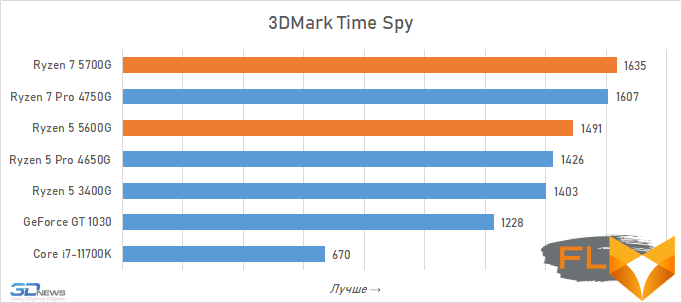
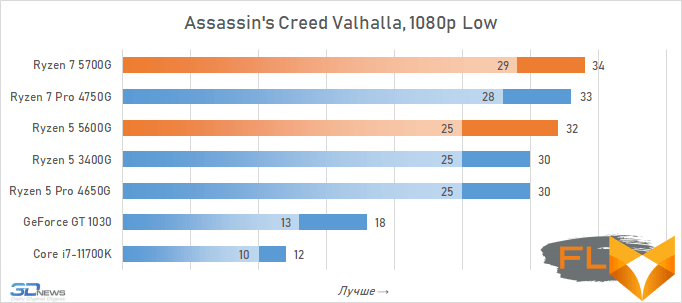
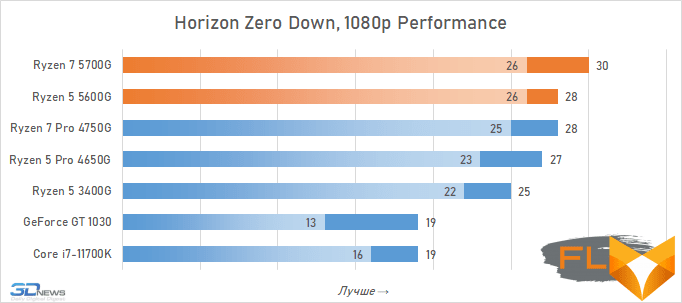
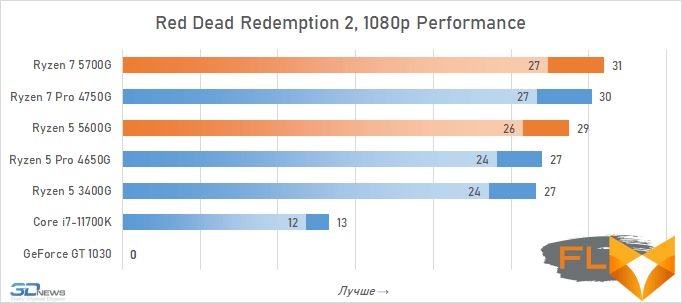
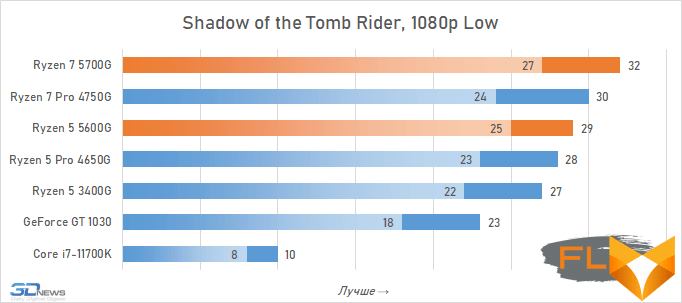



⇡#AMD FSR Technology and Ryzen 5000G Processors
FidelityFX’s Super Resolution technology was originally intended to ease the GPU power requirement to enable ray tracing by lowering the resolution at which rendering is performed. However, the implementation of this technology is such that it does not require anything special to work: it uses simple image scaling using standard GPU ALUs. This makes it possible to enable FSR even on processors with integrated GPUs, which, it would seem, do not have any special computing resources.
Moreover, it is on processors like the Ryzen 7 5700G and Ryzen 5 5600G that FSR technology takes on a special meaning. Here, of course, we are no longer talking about any ray tracing, but with its help you can simply increase the frame rate where it seems insufficient. The drop in image quality does not seem so significant – more detailed information can be obtained from a special article on our website.
AMD FSR technology has four profiles: Ultra Quality, Quality, Balanced and Performance. In them, the resolution at which rendering is performed is reduced by 1.3, 1.5, 1.7 and 2.0 times, respectively, relative to the target. Then the resulting image is “stretched” to the one selected in the settings using a special algorithm that improves clarity and contrast. And if in the case of high-performance graphics cards such an algorithm does not always seem appropriate due to the fact that it somehow damages the detail of the picture, for systems based on hybrid processors, from which no one obviously expects much, it can be used.
To evaluate how much the performance of the integrated Vega graphics core is increased by enabling FSR technology, we conducted tests on a system with a Ryzen 7 5700G processor. The testing ground was two games that have support for AMD FSR:
- Resident Evil Village. Resolution 1920×1080, quality settings profile Balanced.
- Myst (2021). 1920×1080 resolution, Epic quality settings profile.
As can be seen from the results, the inclusion of FSR increases the performance of integrated graphics quite seriously. In the performance upscaling mode, you can achieve an increase in frame rate up to two times. But even the minimum level of Ultra Quality allows you to get an increase in the number of FPS by a third.
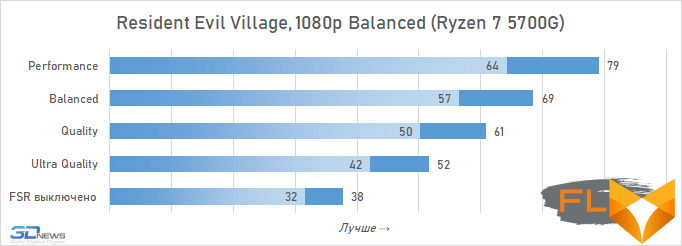
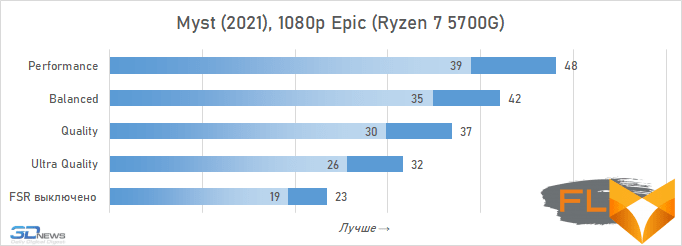
We can say that AMD FSR technology enhances the capabilities of systems built on AMD APUs. If necessary, it really allows you to significantly increase the frame rate in games. However, we do not recommend enabling FSR indiscriminately in all supported games. The picture still deteriorates due to this technology, especially in Balanced and Performance modes, so it is better to rely on this technology only where other means of increasing FPS do not give the desired result and the game is unplayable without it.
⇡#Integrated graphics overclocking and memory frequency impact
Formally, the Ryzen 7 5700G and Ryzen 5 5600G processors support DDR4-3200, but like other modern Ryzen, in reality they are able to work with much faster memory. At the same time, it is well known that the performance of graphics cores built into processors is highly dependent on the bandwidth of the memory used in the system – this is an obvious bottleneck in such configurations. This is where the unspoken recommendation to use the fastest possible DDR4 SDRAM modules in systems with integrated graphics comes from. But how does the performance of Cezanne’s Vega scale with memory speeds?
To answer this question, we’ve game tested the Ryzen 7 5700G with DDR4-2666, DDR4-3200, DDR4-3600, and DDR4-4000 memory modes. In all four cases, the memory controller and the Infinity Fabric bus clocked in sync with the memory. Moreover, as practice has shown, the frequency of 2000 MHz for the Infinity Fabric bus in Cezanne processors is quite achievable and does not cause multiple WHEA (Windows Hardware Error Architecture) errors, as happens with Vermeer processors.



The diagrams hardly need detailed comments. High-speed memory is a prerequisite for the graphics core built into the Ryzen 7 5700G and Ryzen 5 5600G processors to reveal their capabilities. The difference in performance of a similar configuration with DDR4-2666 and DDR4-3600 reaches about 20%. And this means that there is no point in using flagship Cezannes with slow memory – performance will simply move down to the level of cheaper processors with weaker graphics cores. DDR4-3200 modules are the minimum required, which we recommend taking into systems based on the Ryzen 7 5700G and Ryzen 5 5600G, but it is better to focus on the faster DDR4-3600. It is also worth remembering that higher performance will allow you to get two-rank modules. Another way to increase the speed of the Vega integrated graphics core is to increase its frequency. The Ryzen 7 5700G and Ryzen 5 5600G processors make it easy to change the graphics frequency, and what’s more, its overclocking potential is quite substantial. The factory frequency of the integrated GPU in the processors in question is set to 1.9 or 2.0 GHz. But in fact, it can be freely raised to 2.4 GHz, that is, by more than 20 percent. This mode is absolutely functional, no image artifacts appear – they begin to appear only with further attempts to increase the frequency. In particular, because of this, we refused to overclock the GPU to 2.5 GHz – at such a frequency, garbage sometimes falls out on the screen in 3D games.
However, there is no need to talk about high overclocking efficiency. Increasing the frequency of the graphics core by 20% leads to an increase in FPS in games within 6-8%. In other words, the main lever for increasing the performance of integrated graphics is memory. However, no one bothers to use both tools at the same time – the diagrams below show that overclocking the GPU by 400 MHz while increasing the memory frequency by 400 MHz allows you to get a 12% increase in FPS.



Apparently, precisely because of the limitations imposed on the performance of the integrated GPU by the bandwidth of the memory bus, AMD does not seek to raise the frequency of the graphics accelerator in Cezanne. For the same reason, at this stage it is almost pointless to increase the number of computing units in the graphics.
⇡#Processor Performance
The processor performance tests of the Ryzen 7 5700G and Ryzen 5 5600G processors were carried out with the GeForce RTX 3090 discrete video accelerator installed in the system. We compared the main characters with the eight-core and six-core Vermeer (that is, with the familiar Ryzen 5000), Matisse (Ryzen 3000), Comet Lake ( Intel Core 10th generation) and Rocket Lake (Intel Core 11th generation).
- 7-zip 21.02 – archiving speed testing. The time taken by the archiver to compress a directory with various files with a total volume of 3.1 GB is measured. Uses LZMA2 algorithm and maximum compression ratio.
- Adobe Photoshop Lightroom Classic 10.2 – Performance test for batch processing of a series of RAW images. The test scenario includes post-processing and export to JPEG at a resolution of 1920 × 1080 and a maximum quality of two hundred 26-megapixel RAW images taken with a Fujifilm X-T4 digital camera.
- Adobe Premiere Pro 2021 15.2.0 – Performance testing for non-linear video editing. Measures rendering time to YouTube 4K for a project containing HDV 2160p30 footage with various effects applied.
- Blender 2.91.2 – testing the speed of the final rendering in one of the popular free packages for creating three-dimensional graphics. The duration of building the final model pavillon_barcelona_v1.2 from Blender Benchmark is measured.
- Microsoft Visual Studio 2017 (15.9.33) – Compile time measurement of a large MSVC project – Professional 3D Graphics Blender version 2.79b.
- Stockfish 12 – testing the speed of the popular chess engine. The speed of enumeration of options in the position “1q6/1r2k1p1/4pp1p/1P1b1P2/3Q4/7P/4B1P1/2R3K1 w” is measured.
- Topaz Video Enhance AI v1.7.1 – performance testing in an AI-based program to improve video detail. The test uses the original video at 640×360 resolution, which is doubled using the Artemis LQ v7 model.
- V-Ray 5.00 – Benchmark the performance of a popular rendering system using the standard V-Ray Benchmark Next application.
- x265 3.5+8 10bpp – testing the speed of video transcoding to H.265/HEVC format. To evaluate performance, we use the original 2160p@24FPS AVC video file with a bitrate of about 42 Mbps.
As we have already found out before, the Ryzen 7 5700G and Ryzen 5 5600G processors are inferior to the Ryzen 7 5800X and Ryzen 5 5600X both in terms of clock speed and L3 cache size. Therefore, in resource-intensive applications, they perform noticeably weaker. The average superiority of the eight-core Vermeer over the Cezanne of the same number of cores is 18%, and the six-core Vermeer over the six-core Cezanne is 10%. Such a gap leads to the fact that the new AMD APUs, despite the use of Zen 3 cores, lose in performance to representatives of the Rocket Lake family, although they remain more powerful than Comet Lake processors.
So, while standard Ryzen 5000s have become a natural choice for systems used in digital content creation and processing, the same logic should not be applied to processors with integrated graphics. For production systems without discrete graphics cards, Rocket Lake is more profitable: tests show that the Core i7-11700K and Core i5-11600K provide better results compared to the Ryzen 7 5700G and Ryzen 5 5600G.
But on the other hand, Cezanne demonstrate significantly higher performance compared to the previous generation of hybrid processors. In resource-intensive applications, the Ryzen 7 5700G and Ryzen 5 5600G are 25-30% faster than the Ryzen 7 Pro 4750G and Ryzen 5 Pro 4650G, which automatically translates desktop Renoir into the category of hopelessly outdated offers.
Rendering:
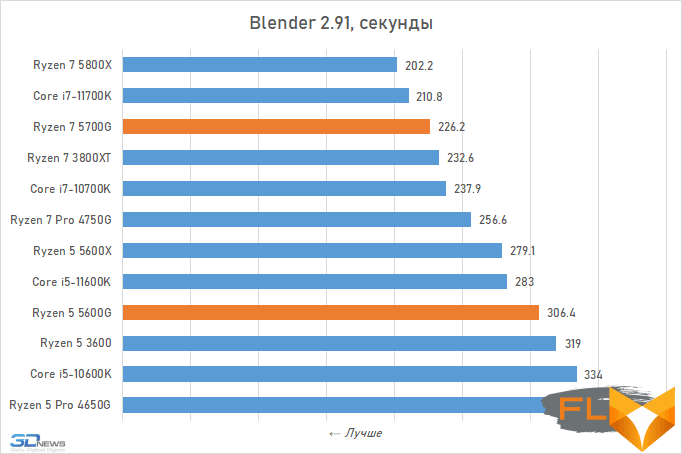
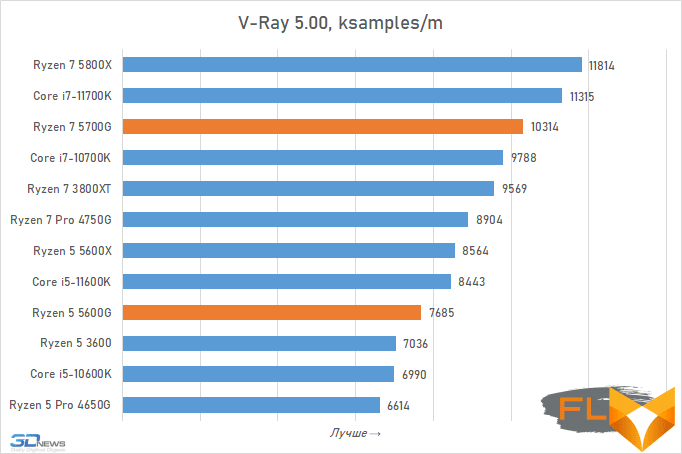
Photo processing:
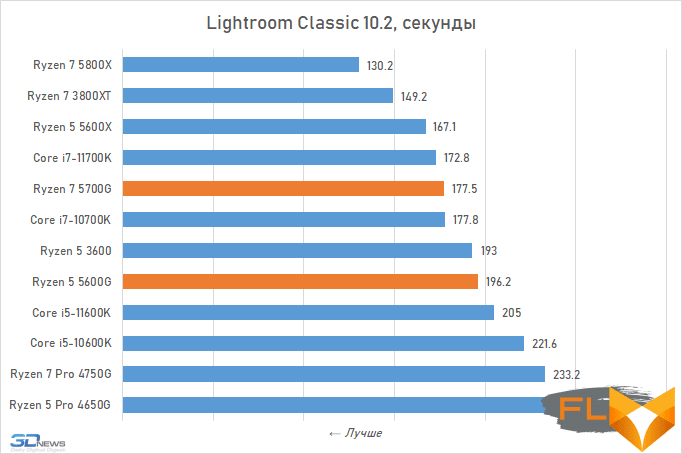
Video work:

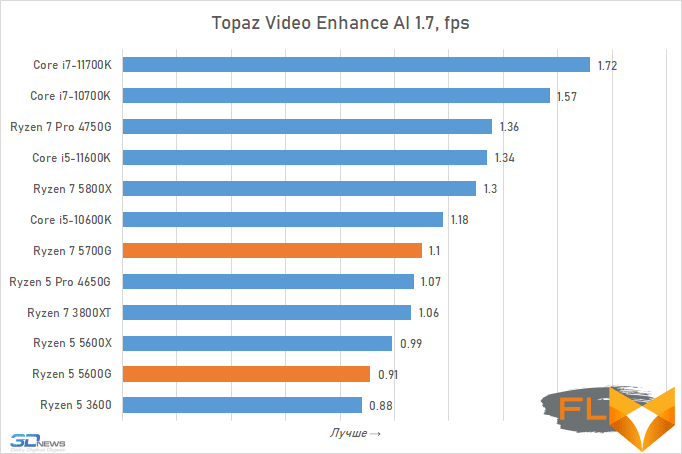
Video transcoding:
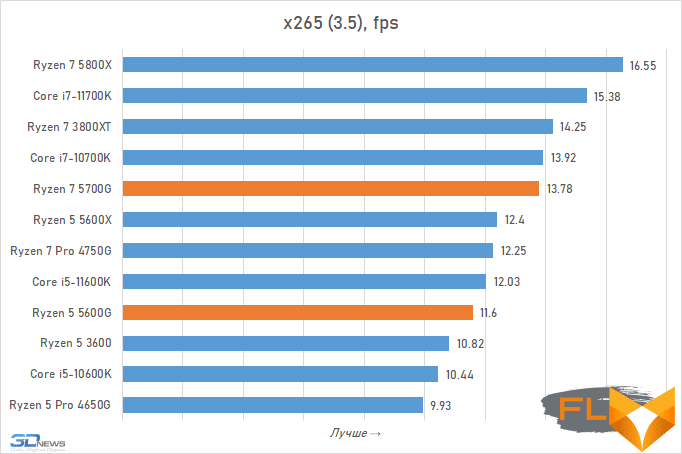
Compilation:
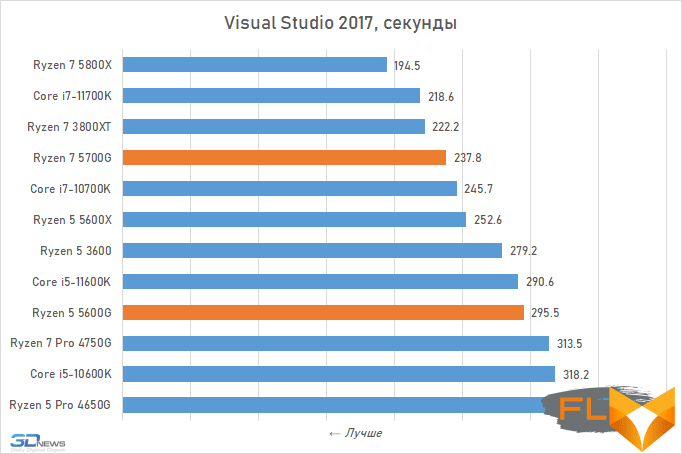
Archiving:
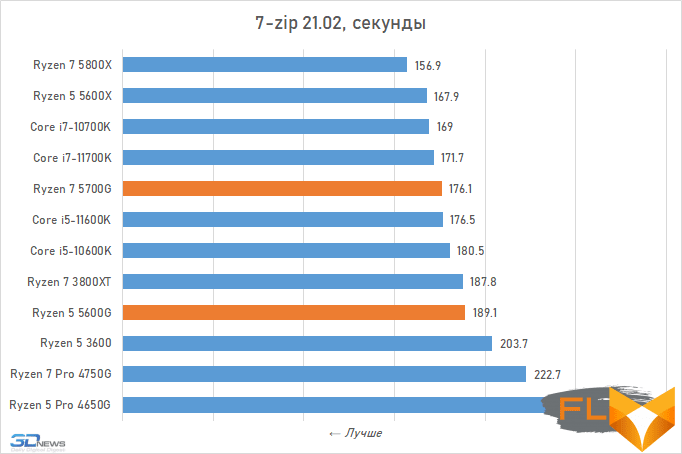
Chess:

⇡#Gaming Performance with Discrete Graphics
The gaming performance of the Ryzen 7 5700G and Ryzen 5 5600G in systems with discrete graphics cards is very important. Firstly, it depends on how interesting the scenario of building a gaming system based on a hybrid processor with the prospect of its subsequent modernization by adding a powerful video card can become. Secondly, AMD encourages Ryzen 7 5700G and Ryzen 5 5600G to be perceived as more affordable options for desktop incarnations of Zen 3, and with this positioning, these processors are able to get into regular gaming assemblies, where a discrete graphics card is provided immediately.
To test how Cezanne cope with the tasks assigned to them, we used the following set of games:
- Assassin’s Creed Odyssey.Resolution 1920 × 1080: Graphics Quality = Ultra High. Resolution 3840 × 2160: Graphics Quality = Ultra High.
- Borderlands 3. Resolution 1920 × 1080: Graphics API = DirectX 12, Overall Quality = Badass. Resolution 3840 × 2160: Graphics API = DirectX 12, Overall Quality = Badass.
- Cyberpunk 2077. 1920×1080 resolution: Quick Preset = Ray Tracing – Ultra. Resolution 3840 × 2160: Quick Preset = Ray Tracing – Ultra.
- Far Cry New Dawn. Resolution 1920 × 1080: Graphics Quality = Ultra, HD Textures = On, Anti-Aliasing = TAA, Motion Blur = On. Resolution 3840 × 2160: Graphics Quality = Ultra, Anti-Aliasing = Off, Motion Blur = On.
- Hitman 3. 1920 × 1080 resolution: Super Sampling = 1.0, Level of Detail = Ultra, Texture Quality = High, Texture Filter = Anisotropic 16x, SSAO = Ultra, Shadow Quality = Ultra, Mirrors Reflection Quality = High, SSR Quality = High, Variable Rate Shading = Quality. Resolution 3840 × 2160: Super Sampling = 1.0, Level of Detail = Ultra, Texture Quality = High, Texture Filter = Anisotropic 16x, SSAO = Ultra, Shadow Quality = Ultra, Mirrors Reflection Quality = High, SSR Quality = High, Variable Rate Shading =Quality.
- Horizon Zero Dawn. Resolution 1920 × 1080: Preset = Ultimate Quality. Resolution 3840 × 2160: Preset = Ultimate Quality.
- Shadow of the Tomb Raider. Resolution 1920×1080: DirectX12, Preset=Highest, Anti-Aliasing=TAA. Resolution 3840 × 2160: DirectX12, Preset = Highest, Anti-Aliasing = Off.
- A Total War Saga: Troy. Resolution 1920 × 1080: DirectX 12, Quality = Ultra, Unit Size = Extreme. Resolution 3840 × 2160: DirectX 12, Quality = Ultra, Unit Size = Extreme.
Cezanne processors did not distinguish themselves by special achievements in terms of gaming performance. It turns out that the success of the classic Ryzen 5000 series in games is largely due to the capacious and unified L3 cache for all cores, which AMD obviously called Game Cache for a reason. And in the case when this cache is reduced in capacity, as is done in the Ryzen 7 5700G and Ryzen 5 5600G, gaming performance is noticeably reduced. If we talk about the situation on average, then the frame rate provided by the Ryzen 7 5700G in Full HD resolution is 15% lower than when using the full octa-core Ryzen 7 5800X. A similar 15% gap in average FPS is also seen between the results of the six-core Ryzen 5 5600G and Ryzen 5 5600X.
And this is a pretty big gap, which ultimately equalizes the gaming performance of Zen 3-based Cezanne processors and Zen 2-based Matisse processors. In other words, when choosing the basis for a gaming system with a discrete graphics card, focus on Ryzen 7 5700G and Ryzen 5 5600G doesn’t make much sense. Processors like the Ryzen 7 3700X and Ryzen 5 3600, which are much cheaper, can deliver about the same performance.
What’s more, it will beat the Cezanne series in games with any of the 10th or 11th generation Intel Core processors with the same number of cores. And therefore, the Ryzen 7 5700G and Ryzen 5 5600G are very far from being the best options for mid-range and higher-end gaming computers. Integrated graphics in Cezanne are good, but when working with discrete graphics cards, they perform weaker than almost any modern alternatives.
Here’s what the situation looks like in Full HD resolution.
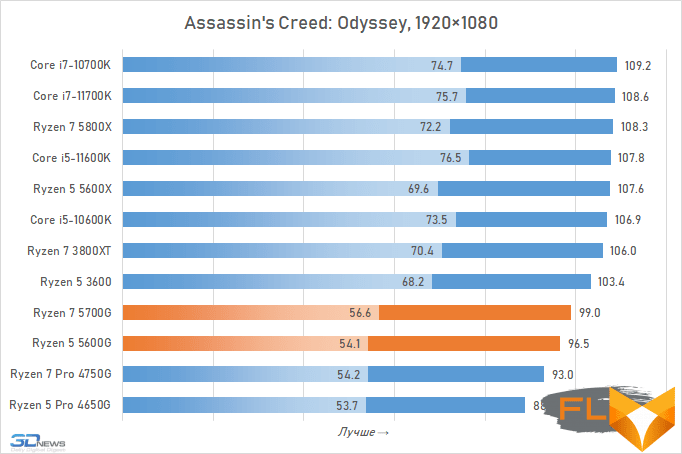
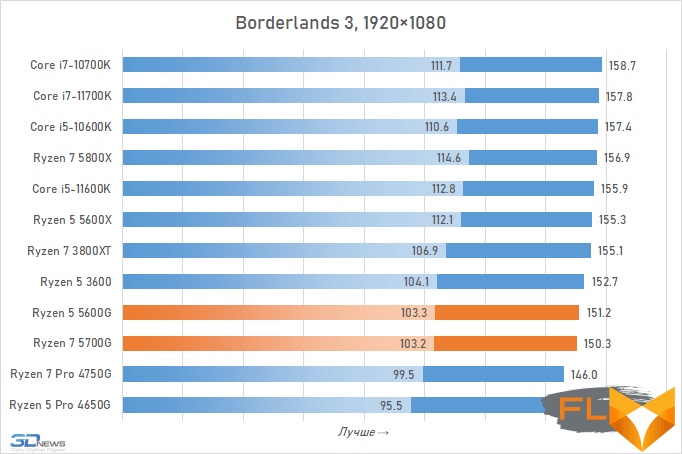
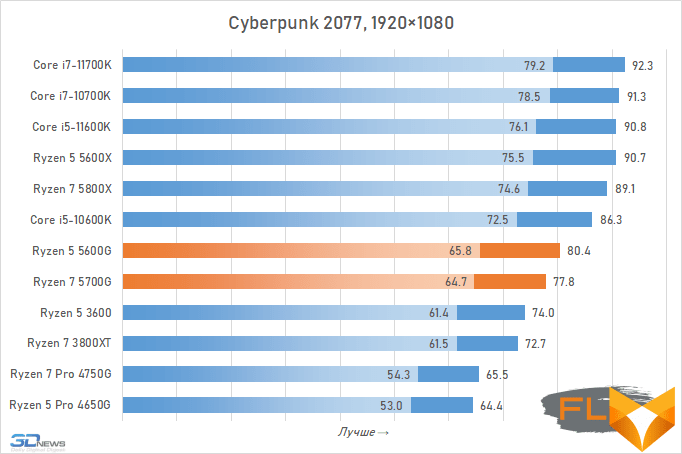
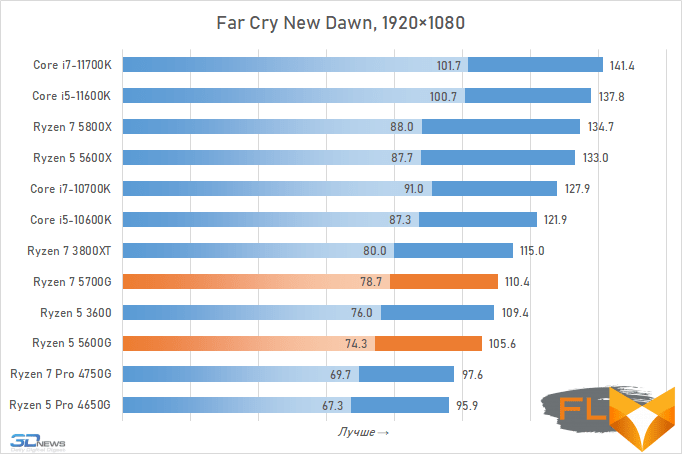
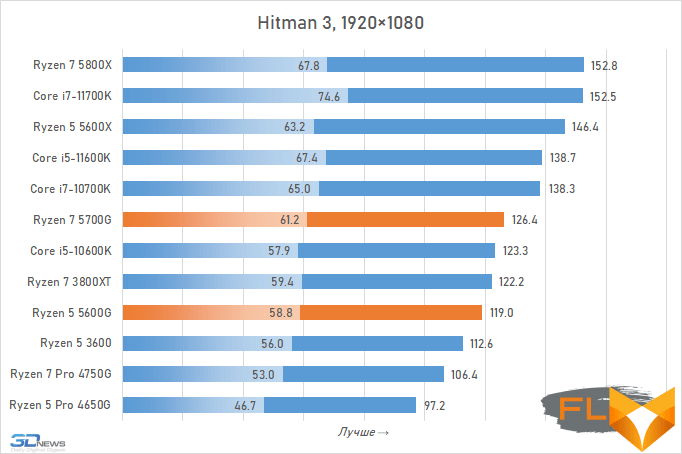
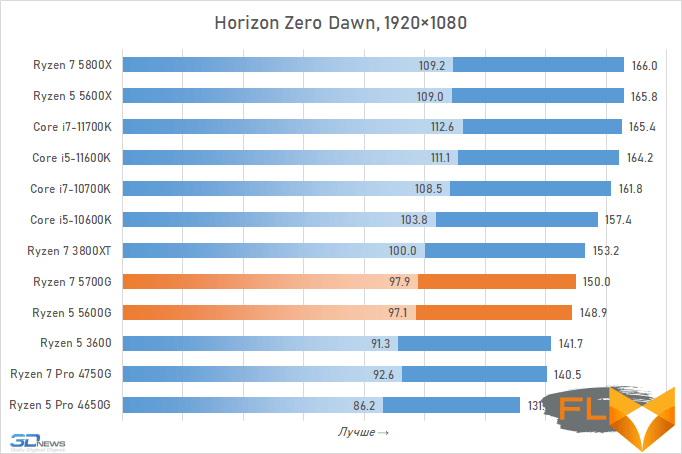
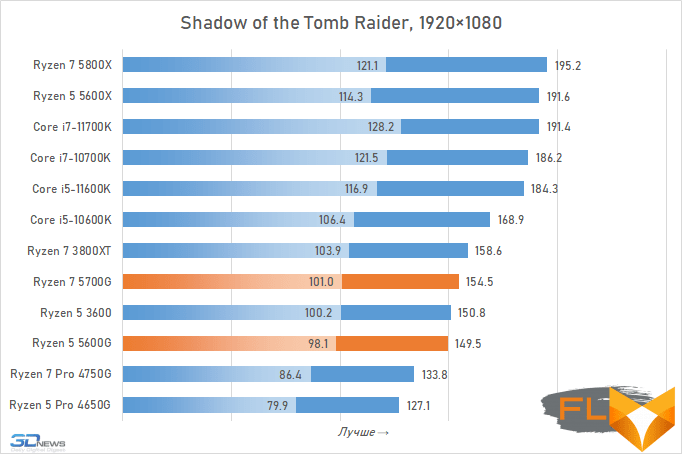
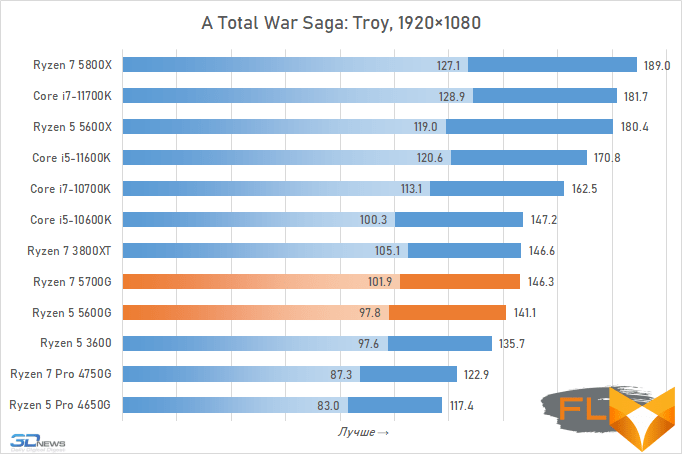
Upping the resolution naturally closes the gap in gaming performance between processors. But even at 4K, the general trend is back, with the Ryzen 7 5700G and Ryzen 5 5600G gravitating toward the bottom of the charts. Worse than Cezanne are only hybrid processors of the previous generation, Renoir. But they are not only based on the Zen 2 microarchitecture, but also have an even smaller L3 cache – only 8 MB.


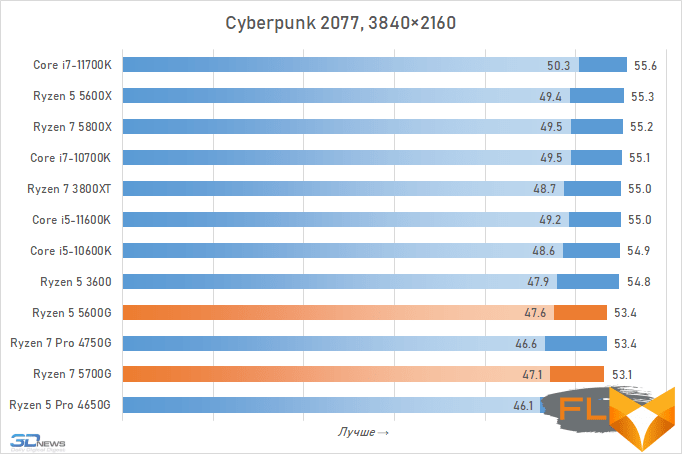
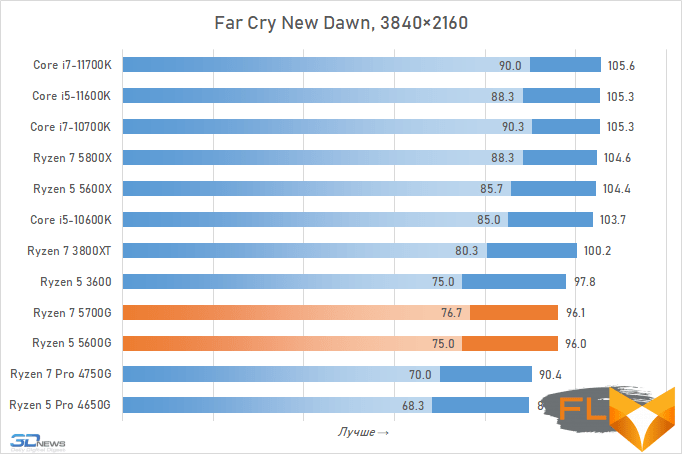

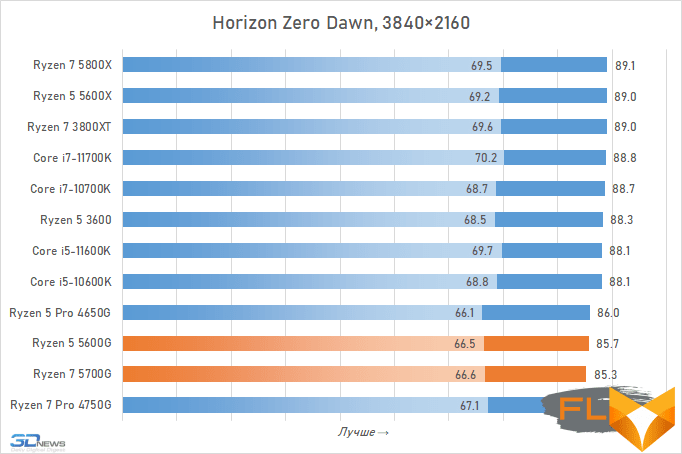
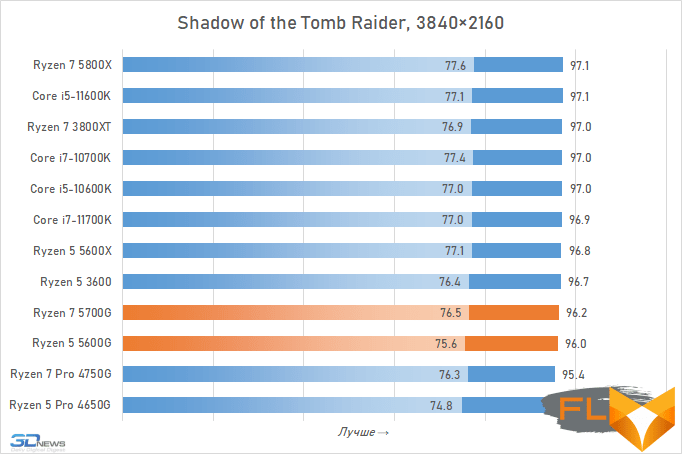
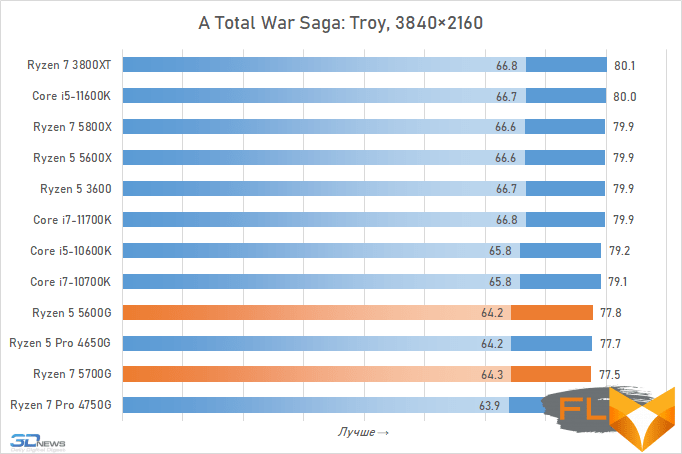
⇡#Conclusions
Due to a shortage of chips, AMD is unable to order the required number of 7nm semiconductor chips from TSMC, and this continues to influence its policy. The first reflection of this factor was the company’s reorientation to the production of more expensive products, but now it has taken another unusual step for itself. AMD decided to combine desktop CPU and APU lineups and present Cezanne processors, originally designed for mobile applications, as a continuation of the Vermeer series – Ryzen desktop processors built on Zen 3 cores.
Technically, this solution looks quite logical: Cezanne is based on the same microarchitecture, and the number of cores in these processors corresponds to the number of cores in typical desktop processors. Therefore, the Ryzen 7 5700G and Ryzen 5 5600G, which should cost a little less than the Ryzen 7 5800X and Ryzen 5 5600X, formally and really can take on the functions of more affordable eight-core and six-core in the Ryzen 5000 series. At least, such a gap that existed before in the characteristics of desktop CPUs and APUs, there should be no more.
However, tests show that a completely universal solution from Ryzen 7 5700G and Ryzen 5 5600G still did not work out. Their use of mobile hardware means lower clock speeds and, even worse, reduced L3 cache. This had a big impact on performance, with the Cezanne family being 15-20% slower than regular Ryzen 5000 series processors with the same core count. As a result, in computationally resource-intensive tasks, representatives of the new generation of APUs lose not only Ryzen 5000 without graphics, but also competing Rocket Lake. And with a gaming load in systems with a discrete video card, everything turns out even worse – any of the modern CPUs is at least as good as a representative of the Cezanne series with the same number of cores.
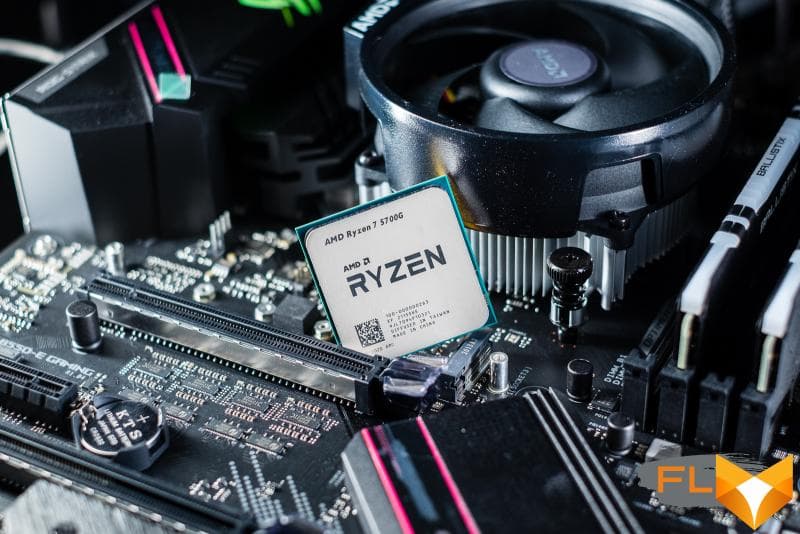
It turns out that the Ryzen 7 5700G and Ryzen 5 5600G, like their predecessors, are still more APUs than conventional desktop processors. Purchasing them for use with a discrete graphics card can only make sense if moving to such a configuration is planned only in the future, and at first the system will rely on the integrated graphics core, which, without any exaggeration, offers the best performance among all available in currently GPUs embedded in desktop processors.
Speaking purely about gaming, the Vega graphics found on the Ryzen 7 5700G and Ryzen 5 5600G really make a very good impression. Its power is enough to run the latest games in Full HD resolution with low quality settings and an acceptable frame rate. And in undemanding esports disciplines, it can pull even medium or high settings. Therefore, Cezanne can be a good way out for those gamers who are not ready to buy graphics cards at current prices. In addition, these processors can completely replace entry-level discrete graphics cards, as they outperform them in performance, and a configuration based on one of the new generation APUs reviewed looks clearly more attractive than a combination of a regular CPU and GeForce GT 1030-level graphics.
But here we need to make an important caveat: the integrated graphics in Cezanne are based on an old architecture that has not been developed in any way for a long time. The Ryzen 7 5700G and Ryzen 5 5600G offer exactly the same graphics core as their predecessors, and the small increase in integrated GPU gaming performance that occurred compared to the Renoir is provided by an increase in the power of the processor cores. But the problem lies not in the lack of performance gains, but in the fact that AMD’s integrated graphics stopped adding important features a long time ago. For example, the Vega core built into Cezanne processors is a unique graphics accelerator by modern standards that does not support AV1 hardware decoding. In light of the widespread transition to this codec for streaming services, in the future this may become a noticeable headache for owners of the Ryzen 7 5700G and Ryzen 5 5600G, unless, of course, they eventually switch to discrete graphics.
Ultimately, the Cezanne family of desktop processors do not look as universal and not as comprehensive solutions as they seemed at first, especially considering that the real prices also turned out to be higher than AMD promised. But the truth is that when you need to build a system that can temporarily do without a graphics card, there is nothing better than the Ryzen 7 5700G and Ryzen 5 5600G. Moreover, an assembly based on them will have a good “growth” reserve: you can later add a video card to it and get a computer, albeit not brilliant, but still with quite acceptable gaming performance.
